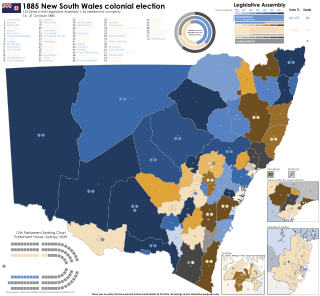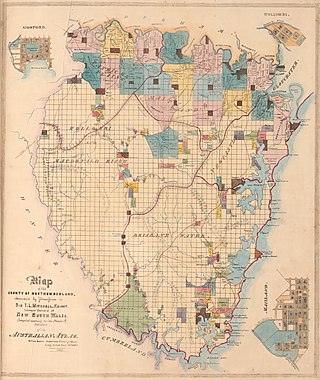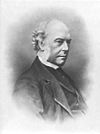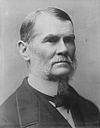
Sir Joseph Palmer Abbott, was an Australian politician, pastoralist and solicitor.
John Ryan Brenan was an Australian politician and an elected member of the New South Wales Legislative Assembly for 68 days in 1856. He founded, and outlined, the suburb of Smithfield in Sydney. Furthermore, Brenan Park, which is in that suburb, was named after him.

Peter Faucett was an Australian barrister, judge and politician. He was a member of the New South Wales Legislative Assembly between 1856 and 1865. He held the position of Solicitor General in the first government of James Martin. He was a judge of the Supreme Court between 1865 and 1888 and a member of the New South Wales Legislative Council between 1888 and 1894.
Thomas George Rusden was a squatter and politician in colonial New South Wales. He was a member of the Legislative Council between 1855 and 1856 and a member of the Legislative Assembly for one term between 1856 and 1857.
John Norton Oxley was an Australian farmer and politician. He was a member of the New South Wales Legislative Assembly for one term between 1856 and 1857.
The third Cowper ministry was the seventh ministry of the Colony of New South Wales, and third occasion of being led by Charles Cowper.

Richard Thomas Ball was a politician and engineer in New South Wales, Australia.

Sir Robert Wisdom, was a politician in colonial New South Wales and Attorney General of New South Wales.

The Electoral district of County of Durham was an electorate of the New South Wales Legislative Council at a time when some of its members were elected and the balance were appointed by the Governor. It was named after Durham County, which lies on the north side of the Hunter River.

The Electoral district of Counties of Gloucester, Macquarie, and Stanley and from 1851, Gloucester and Macquarie, was an electorate of the partially elected New South Wales Legislative Council, created for the first elections for the Council in 1843. The counties of Gloucester and Macquarie were the settled coastal areas north of Northumberland County, while the County of Stanley was the area surrounding Brisbane, in what became part of Queensland after its separation in 1859. Polling took place at Raymond Terrace, Port Macquarie, Dungog, Stroud, Brisbane, Ipswich and Mr Rowley's residence on the Manning River. The County of Stanley was removed from the district with the expansion of the Council in 1851 and became the districts of County of Stanley and Stanley Boroughs.

The 1885 New South Wales colonial election was held between 16 October and 31 October 1885. This election was for all of the 122 seats in the New South Wales Legislative Assembly and it was conducted in 37 single-member constituencies, 24 2-member constituencies, seven 3-member constituencies and four 4-member constituencies, all with a first past the post system. Suffrage was limited to adult male British subjects, resident in New South Wales. The previous parliament of New South Wales was dissolved on 7 October 1885 by the Governor, Lord Augustus Loftus, on the advice of the Premier, George Dibbs.

Alban Joseph Riley was an Australian politician. He was mayor of the City of Sydney and a Member of the New South Wales Legislative Assembly.

The 1860 New South Wales colonial election was held between 6 December and 24 December 1860. This election was for all of the 72 seats in the New South Wales Legislative Assembly and it was conducted in 52 single-member constituencies, six 2-member constituencies and two 4-member constituencies, all with a first past the post system. Suffrage was limited to adult white males. This was the first election after the separation of Queensland in December 1859.
Benjamin Lee was an English-born Australian politician.
Charles Kemp was an English-born Australian politician.

The Electoral district of County of Northumberland and from 1851, Northumberland and Hunter, was an electorate of the partially elected New South Wales Legislative Council, created for the first elections for the Council in 1843. The County of Northumberland was bounded by the part of the Hawkesbury River to the south, the Macdonald River to the south-west, and the Hunter River to the north, however the electoral district did not include the towns of East Maitland, West Maitland and Newcastle which made up the district of Northumberland Boroughs. Polling took place at Gosford, Newcastle, East Maitland, Wollombi, Singleton and Watson's on the Macdonald River. The County of Hunter was added to the district with the expansion of the Council in 1851 and elected two members.

The Electoral district of Northumberland Boroughs was an electorate of the partially elected New South Wales Legislative Council, created for the first elections for the Council in 1843. From 1843 until 1851 the electorate covered the major towns or boroughs of Northumberland County, East Maitland, West Maitland and Newcastle, and polling took place at East Maitland, West Maitland and Newcastle. Morpeth was added to the electorate from 1851 while Newcastle was removed from the electorate to form, with Raymond Terrace, the North Eastern Boroughs. The rest of Northumberland County was covered by the County of Northumberland from 1843 until 1951, and Counties of Northumberland and Hunter from 1851 until 1856.
Liverpool Plains, an electoral district of the Legislative Assembly in the Australian state of New South Wales, had three incarnations, from 1859 to 1880, from 1904 to 1920 and from 1927 to 1962.
Gwydir, an electoral district of the Legislative Assembly in the Australian state of New South Wales had two incarnations, from 1859 until 1894 and from 1904 until 1920.












